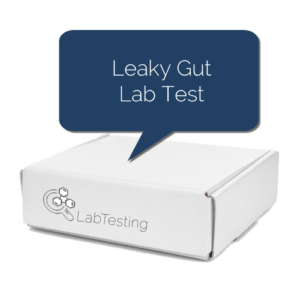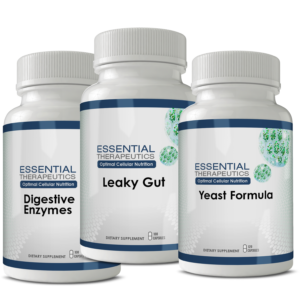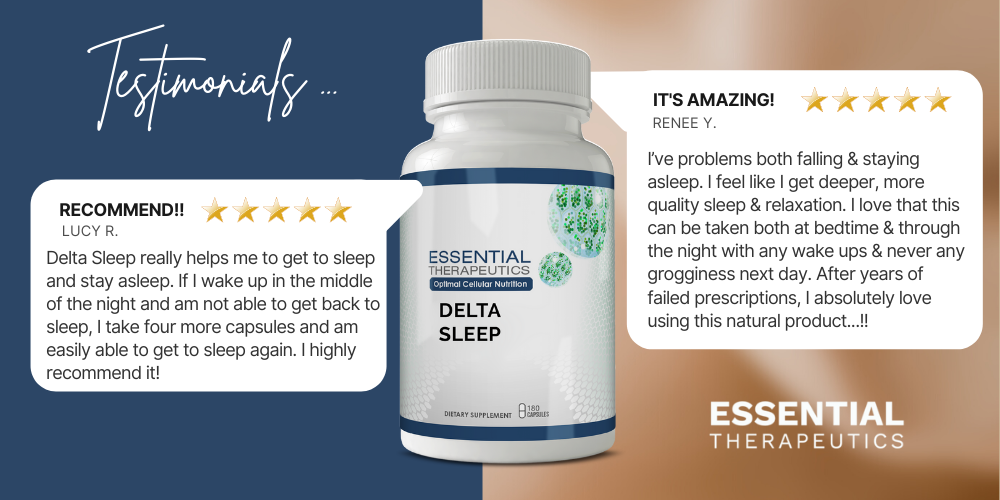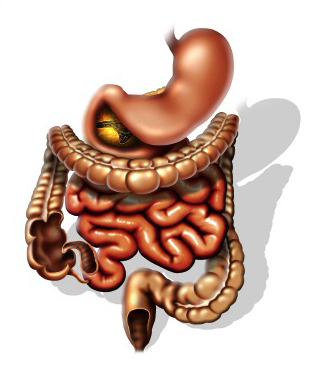 Yeast Overgrowth
Yeast Overgrowth
Candida albicans is a particular form of yeast found living in the intestinal tracts of most individuals. Yeasts cohabitate in a symbiotic relationship with over 400 healthy intestinal bacteria. These bacteria help produce short-chain fatty acids, vitamin K, biotin, vitamin B12, thiamin, and riboflavin. These bacteria also keep the yeast that inhabit our intestinal tract in check. When these good bacteria die (from antibiotics) or are suppressed (by prescription steroids), the yeasts are allowed to grow to unhealthy levels, causing dysbiosis. Yeast overgrowth is similar to food allergies in that there are a plethora of associated symptoms. This can lead to skepticism in many doctors; the symptoms are tough to define. Candidiasis commonly infects the ears, nose, and urinary and intestinal tracts.
Signs and Symptoms of Yeast Overgrowth
• constipation, diarrhea, and irritable bowel syndrome
• abdominal pain
• bloating, gas, and indigestion
• rash
• bladder spasms and infections,
• ear infections
• sinus infections
• rectal itching
• itchy ears or nose
• sugar or starch cravings
• white tongue (thrush)
• toe or finger nail infections
• jock itch
• chronic vaginal yeast infections
• intestinal permeability
• increased body odor
• PMS
• asthma
• depression
• chronic fatigue
Like most opportunistic infections, Candida and other yeasts may increase during times of stress. This overgrowth leaks toxins into the bloodstream or other tissues, allowing antigens (foreign invaders) to set up residence in various bodily tissues. Antigens then trigger complex allergic reactions. (This might explain why most individuals with chronic yeast overgrowth develop food, inhalant, and environmental allergies).
Allergic reactions can manifest in a variety of symptoms: fatigue, brain fog, depression, joint and muscle pain, digestive disorders, headache, rash, and breathing problems. Inflammation of the nose, throat, ears, bladder, and intestinal tract, can lead to infections of the sinus, respiratory, ear, bladder and intestinal membranes. In an attempt to arrest these infections, doctors might prescribe a broad spectrum antibiotic. Such antibiotics promote yeast overgrowth and often times, additional symptoms. It invades the intestinal wall creating intestinal permeability. This allows toxins from microorganisms and protein molecules from your food enter the blood stream.
Remember, yeast feeds on sugars and on carbohydrates that easily convert to sugars. In turn, yeasts produce a series of chemical products as waste, among which are acetaldehyde and ethanol. Ethanol is alcohol, and there are cases of people who have never drunk a drop of alcohol yet are daily inebriated. Acetaldehyde is produced as the alcohol breaks down and is about six times more toxic to brain tissue than ethanol.
Want to know if you have Leaky Gut?
Take the urine based leaky gut test. Normally $299 use this discount code at checkout: LEAKYGUT19 and save $70!
With code only $229! –> BUY NOW!
What Causes Yeast Overgrowth?
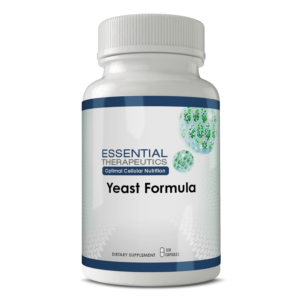 Birth control pills, food allergies, antibiotics, and corticosteroid therapy are all initiators of yeast overgrowth. A minor increase in intestinal yeast is usually not a problem, leading possibly to infection of the mouth (thrush) or vaginal lining (vaginitis or “a yeast infection”). The body’s immune defenses are usually strong enough to keep the yeast from taking over the intestinal tract. However, if yeast overgrowth is left unchallenged, more sinister symptoms appear. Yeasts can change into an invasive mycellial fungus with rhizoids (tentacle-like projections) that penetrate the lining of the intestinal tract. These projections can cause intestinal permeability and leak toxins across the cellular membranes.
Birth control pills, food allergies, antibiotics, and corticosteroid therapy are all initiators of yeast overgrowth. A minor increase in intestinal yeast is usually not a problem, leading possibly to infection of the mouth (thrush) or vaginal lining (vaginitis or “a yeast infection”). The body’s immune defenses are usually strong enough to keep the yeast from taking over the intestinal tract. However, if yeast overgrowth is left unchallenged, more sinister symptoms appear. Yeasts can change into an invasive mycellial fungus with rhizoids (tentacle-like projections) that penetrate the lining of the intestinal tract. These projections can cause intestinal permeability and leak toxins across the cellular membranes.
Treatment of Yeast Overgrowth
The Candida Diet
• Avoid sugar for at least three months. Sugar is the chief nutrient for Candida albicans, so restricted sugar intake is absolutely necessity to effectively treat chronic Candidiasis. Avoid refined sugar, honey, maple syrup, fruit juice, milk, white potatoes, corn, beans, processed or bleached (white) flour, bakery goods, muffins, cereals, and anything containing sugar. This includes ice cream, cake, cookies, and other sweets; potato or corn chips, pretzels, or crackers; and dried fruits, including raisins.
• Avoid alcoholic beverages, malted milk, and other malted products for at least two months.
• Avoid mold- and yeast-containing foods for at least two months. These include peanuts, dried fruits (including prunes, raisins, and dates), vinegar, pickled vegetables, sauerkraut, relishes, green olives, vinegar-containing salad dressings, catsup, mayonnaise and, pickles.
• Avoid milk and dairy products for at least two months. All natural (unsweetened) yogurt is allowed.
• Avoid fruits and fruit juice (for at least two weeks. After two weeks, try introducing apples and pears to see if you have any reactions. (Reactions might include fatigue, depression, aches and pain, rectal itching, itching of the ears or nose, and digestive disturbances.) If not, then try berries: strawberries, blueberries, blackberries, and raspberries. Avoid all other fruits.
• Most vitamin and mineral supplements purchased at a drug store are contaminated with yeast. Follow your doctor’s recommendations about which supplements are acceptable. Of course all of the Essential Therapeutics products including the multivitamin/mineral formulas are free of yeast, sugar, wheat, gluten, dairy, and other additives.
• Take one tablespoon of virgin olive oil each day on your salads or vegetables. Add lemon juice it you’d like.
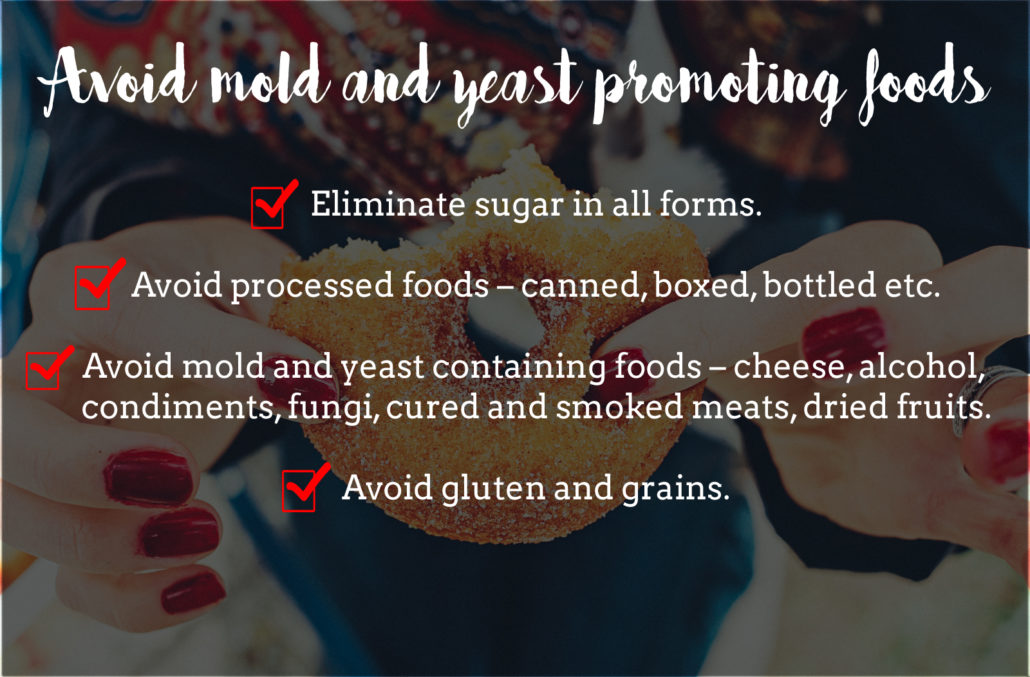
Candida Diet Allowable:
• vegetables and salads (remember your olive oil!)
• meats and proteins (lean cuts)
• fish and shellfish
• game birds and animals
• nuts and seeds (in small amounts)
• cold-pressed or expeller-pressed, non-hydrogenated oils
• artificial sweeteners (plant-based like Stevia or FOS are best). Fructo-oligosaccharide (FOS) is a short-chain polysaccharide used in Japan for dozens of years. It isn’t digested by humans but does stimulate the growth of good bacteria within the intestinal tract. It also helps with liver detoxification, lowers cholesterol, and eliminates various toxins. It can be used as a natural sweetener. Dosage for powder is 2,000–3,000 mg. daily. Stevia is a remarkable (no calories, no carbs) herb, native to Paraguay. It has been used as a sweetener and flavor enhancer for centuries.
• butter (not margarine)
• one cup of old-fashioned oatmeal per day
Herxheimer Reaction
Sometimes, when a lot of Candida organisms are killed off during initial treatment, a sudden release of toxic substances results in an immune response and intensified symptoms, called the herxheimer reaction. The body becomes extremely acidic. This is known as a die-off reaction. It normally lasts no longer than a week and is frequently confused as an allergic or adverse reaction to the antifungal treatment.
Symptoms can be minimized by taking Alka-Seltzer Gold or 2 tablespoons baking soda in 8 oz. of water two–three times daily as needed.
If the reaction is severe, you might need to reduce your antifungal medications. Half the dosage (or take every other day) for a week and then return to the original dose. Then continue antifungal medications for a minimum of three months. If treatment is discontinued too early, symptoms will gradually return.
Once fungus overgrowth has subsided and yeast levels have returned to normal (three–four months), medications and supplements can be gradually decreased over six–eight weeks, and you can gradually add previously forbidden foods to your diet. Continue to be vigilant in monitoring your sugar and simple carbohydrate intake.
Yeast Overgrowth Protocol
Step 1: Eliminate yeast-producing foods with the Candida diet above. Also make sure you’re taking yeast-free supplements.
Step 2: Improve digestion. Gastric hydrochloric acid and pancreatic enzymes help keep Candida from overgrowing in the small intestine. Patients on Zantac, Nexium, or other acid-blocking drugs increase their risk for developing yeast overgrowth.
• Supplement with pancreatic enzymes with each meal.
• Supplement with betaine hydrochloric acid with each meal. Yeast can’t live in an acidic environment.
Step 3: Replace good bacteria, such as Lactobacillus acidophilus, L. bulgaricus, L. catnaforme, L. fermentum, and Bifidobacterium bifidum. These normally inhabit vaginal and gastrointestinal tracts; help digest, absorb, and produce certain nutrients; and keep potentially harmful bacteria and yeast in check.
Yogurt contains certain strains of good bacteria, but it isn’t standardized for a particular amount. Also, most yogurts are made from L. bulgaricus or Streptococcus thermophilus. Both are friendly bacteria, but neither will help colonize the colon. So it’s best to use live organisms that are shipped on ice and then kept refrigerated until purchase. Live L. acidophilus and B. bifidum powders or capsules are preferred.
• Supplement with probiotics for three months: 5–10 billion organisms on an empty stomach each day. Some extremely resistant yeast infections may need continuous probiotic replacement therapy.
Step 4: Reduce liver toxicity. Always take milk thistle and or alpha lipoic acid when taking yeast overgrowth (antifungal) prescription or natural medication.
Step 5: Treat your intestinal permeability. Yeast overgrowth can cause intestinal permeability and contribute to food sensitivities or allergies. Treat leaky gut and yeast overgrowth at the same time.
Step 6: Use prescription or natural antifungal medicines. –> Essential Therapeutics Yeast Formula
I use a product called Yeast Formula with the following ingredients:
• calcium undecylenate 150 mg. Undecylenic acid (10-Undecylenic acid) is one of the most powerful anti-yeast medications available. It is a mono-unsaturated fatty acid found in the body (occuring as sweat) and is produced commercially from castor bean oil. It has been used as a topical (Desenex) and oral antifungal medication.
• sorbic acid 50 mg.
• beberine sulfate 200 mg.
• Indian barberry (Berberis aristata) min. of 6% berberine 50 mg.
• Chinese goldenthread, min. 20% berberine 25 mg. Another form of Beberine.
• green tea leaf, min 80% 50 mg. The polyphenols in green tea kill harmful bacteria and promote the growth of friendly bacteria (bifidobacteria).
I have patients take one tablet a day and slowly increase up to three tablets a day with food. This concentrated, broad-spectrum formula combines specific natural agents useful in supporting a healthy balance of intestinal microflora, thus discouraging the overgrowth of yeast. Sustained-release and pH balanced, this potent formula is readily absorbed into the small and large intestine.
Other Natural Antifungal Medications
• Caprylic acid is a naturally occurring fatty acid and a potent antifungal medicine. It should be taken as an enteric-coated timed-release capsule. Dosage is 500–1,000 mg. three times daily with food. The Caprylic Acid is fungicidal for Candida albicans. It is harmless to friendly intestinal flora, and effective against the invasive mycelial form as well as the yeast form, because it is absorbed by the intestinal mucosal cells. Caprylic Acid is metabolized by the liver and does not get into the general circulation. It must exert its fungicidal effect in the intestinal tract or not at all. According to studies, just ten minutes after oral intake of straight caprylic acid, more than 90% can be traced in the portal vein on its way to the liver. Consequently, caprylic acid should be taken with psyllium powder which will form a gel in the intestinal tract and release the caprylic acid trapped within over a period of time.
• Oleic Acid, the major (56–83%) component of virgin olive oil, hinders conversion of Candida albicans yeast to the more harmful mycelial fungal form.
• Berberine (sulfate) has a wide range of antimicrobial properties. It is a proven herbal medicine used successfully to treat fungal, bacterial, and parasitic infections. Dosage of standardized extract (4:1) is 250–500 mg. three times daily with food.
• Garlic has been used for medicinal purposes for centuries. It is an effective treatment for the overgrowth of Candida albicans and other yeasts. It has been shown more potent than Nystatin for Candida albicans. Dosage of standardized garlic (1.3% alliin) is 600–900 mg. two–three times daily with food.
Prescription Medications for Yeast Overgrowth
Prescription drugs include Nizoral, Nystatin, and Diflucan. Nystatin is the safest of the three, because it doesn’t penetrate the intestinal lining. However, this is also one reason I find it less helpful than other prescription drugs. The majority of the yeast sensitivity assays I see from positive stool samples show that Nyastatin is usually the weakest prescription medication. Most prescription anti-fungals, including Nizoral and Diflucan, have potentially serious side effects and should be used with caution. Those with yeast overgrowth must weigh the benefits and risks, but treating a raging infection with anything other than prescription medication might be futile.
What’s Recommended
Good Gut Health Pack is highly recommended when dealing with a yeast overgrowth issue. –> LEARN MORE

